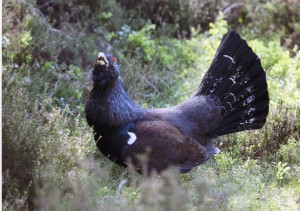 There are a number of groups of birds in the Highlands that cause controversy from a number of different angles. For example, birds of prey are an obvious one. The hen harrier has probably caused more controversy in the last two decades than any other bird on the British list. The main problem is the so called conflict between hem and grouse moors as these birds are reputed to take large numbers of grouse chicks. In contrast who would have thought the buzzard would ever increase in such numbers as to promote the argument that they damage the populations of smaller birds. Unfortunely for the buzzards such deaths are also reputed to take place in release pens where young pheasants have been retained for the shooting season. Then again what about the demands for action from farmers and crofters over the food of the comparatively recently introduced sea eagles? These enormous eagles are reputed to be taking flock threatening numbers of live, healthy lambs each spring.
There are a number of groups of birds in the Highlands that cause controversy from a number of different angles. For example, birds of prey are an obvious one. The hen harrier has probably caused more controversy in the last two decades than any other bird on the British list. The main problem is the so called conflict between hem and grouse moors as these birds are reputed to take large numbers of grouse chicks. In contrast who would have thought the buzzard would ever increase in such numbers as to promote the argument that they damage the populations of smaller birds. Unfortunely for the buzzards such deaths are also reputed to take place in release pens where young pheasants have been retained for the shooting season. Then again what about the demands for action from farmers and crofters over the food of the comparatively recently introduced sea eagles? These enormous eagles are reputed to be taking flock threatening numbers of live, healthy lambs each spring.
Another group of birds that causes endless controversy is the grouse family all of whom are found in the Highlands. The commonest of these, and perhaps by far the most controversial, is the red grouse. No bird in the UK is managed more intensely than this game bird. So far it has proved impossible to hand rear these so the numbers rely on intense management of their main habitat. This is open moorland with varying stages of heather growth and age. There also has to be intense management of any would be predators such as foxes. The control of birds of prey who predate red grouse is the subject of very much controversy. Other members of the grouse family include the black grouse and the ptarmigan but perhaps the top of the grouse list, in a number of ways, is by far the largest, the famous capercaillie.
The capercaillie, often called simply the “caper” has had a chequered history, including in the Highlands. The last known indigenous capercaillie was, arguably, shot on Deeside in 1785 and it was re-introduced, mainly for sport, in the 1830s when birds were brought in from Sweden. It means that today’s dwindling numbers are entirely descended from the introduced birds. For me capercaillie always brings back one memory of them, albeit as far back as 25 years ago. I went for a walk in Glen Affric and the reader can imagine the scene as I approached one of my favourite places, the Corrie Loch, on the Dog Falls way marked route. Suddenly there was a loud clatter of wings as a hen and a cock capercaillie flew out from the trees surrounding the loch. No doubt they had been feeding on some of their favourite foods, the needles, buds and small cones of the Scots pine. The droppings of the capercaillies are large, about the size of a goose dropping, and all around the loch it looked as though a small flock of geese had been feeding. That was how common were the capercaillie in Glen Affric in those days. According to my sources it is now a long time since any capercallies have been seen in this enormous area of the old Caledonian pine forest. Elsewhere in the Highlands and UK the numbers are still falling for a variety of reasons with under a 1,000 birds in 2002.
The origin of the name capercaillie has always been open to debate. Other names include the “Great Grouse” which relates to the fact that it is the biggest grouse in Europe as it is as big as a full grown turkey. As to the name capercaillie, one school of thought thinks it came from the Gaelic meaning “Horse of the Woods” relating to its size. Another is “Old man of the Woods” or “Goat of the Woods” the latter relating to the goat like chin feathers of the cock.
